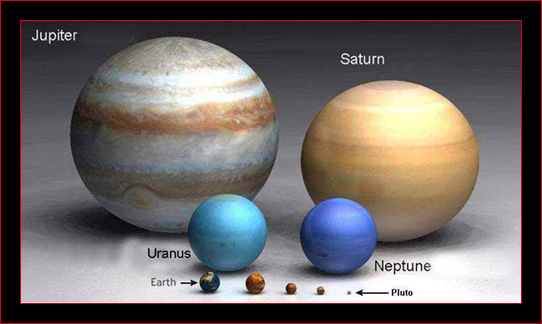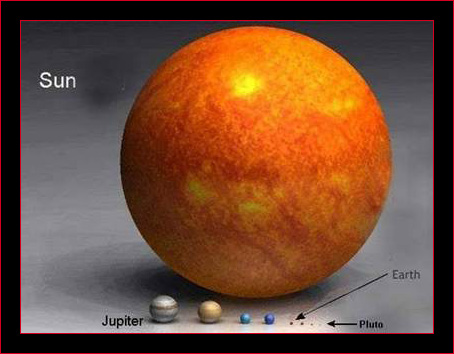
|
|
This image has all nine planets in our solar system somewhat to scale. Even if one is aware of the relative size of the planets this remains
a fairly remarkable comparison between the gas/ice giants (Jupiter, Saturn, Uranus & Neptune) and the rocky inner planets (Mercury, Venus, Earth & Mars).
Pluto again is a bit of an exception being the last planet in our solar system and way out in the Kuiper Belt (Kuiper – pronounced to rhyme with viper)
with the gas giants between it and Earth. Pluto is quite small in comparison to even Mars and Mercury as viewed in this image.
|

|

|
My astronomy associates and I often explain to students and the general public when speaking at events and star parties about the size of our Sun in relation to
everything else in our solar system. Trying to fathom just how large our star is can be rather difficult to impart to average folks. After all it’s a yellow
dwarf with a spectral classification of G2 V and fairly common – it’s one of perhaps more than 100 million G2 stars in our galaxy. However, it alone accounts
for 99.9% of the mass of our solar system. This includes all the planets, satellites (moons), asteroids, meteoroids, comets and a plethora of dust and anything
else that’s out there. Another point that makes it far from ordinary, common or typical... It is the only known star that supports life… This was pointed
out during a lecture by a well known professor and made a great deal of sense to me. I was once told this wasn’t an appropriate point to make when speaking
to some students. If any of you out there who may happen to read this can identify with absolute certainty another star that is known to support life
please let me know – we could become famous…
|
The ‘G2’ classification of our Sun indicates it has a surface temperature of approximately 10,000° Fahrenheit (5,500 Kelvin - thanks to Professor Steven Fawl of Napa Valley College for clarifying this information), about the middle of the temperature scale for stars, giving it a white color. Because of atmospheric scattering this color appears yellow. This is a subtractive effect, as the preferential scattering of blue photons (our blue sky color) removes enough blue light to leave a residual reddishness that is perceived as yellow. The Roman numeral ‘V’ indicates that the Sun is typical in its class and is a main sequence star. If you need to know more use this link: Our Sun. You’ll learn more than one would ever need to know and this is just one of many, many resources available. In the meantime take a look at the comparative size in the next image below; it’s quite impressive…
|
Now that you have some idea of the size of our Sun in relation to the balance of our solar system, let’s compare it to some other stars. The image at right compares
our Sun with Sirius (Alpha Canis Majoris), Pollux (Beta Geminorum) and Arcturus (Alpha Bootis). The scale is fairly astounding in my view,
what do you think? Note the size of ‘giant’ Jupiter (only 1 pixel in this perspective)… And Earth wouldn’t even register on this scale…
|

|

|
Last but not least in our ‘perspective’, let’s compare our Sun to a few large stars in the heavens as indicated by the image at left. Note our Sun is a mere
spec compared to some of these bad boys and mighty Jupiter doesn’t even warrant a glimpse… Betelgeuse (Alpha Orionis – this star should actually be the
Beta star in Orion; the Bayer designation is incorrect in this case as Rigel is slightly brighter) is an M2Ib red supergiant and physically one of the
largest stars known. If Betelgeuse took the place of our Sun its outer surface would extend between the orbit of Mars and Jupiter. Antares (Alpha Scorpii)
is also a red supergiant and extremely large – about 700 times the diameter of our Sun and one of the brightest stars in the heavens.
If you can't read the small print, from left it reads as follows: 'Jupiter is invisible at this size'; the 'Sun (1 pixel)' has an arrow pointing to it; the three stars noted below Antares are Sirius, Pollax & Arcturus. The image at left is a corrected version uploaded in August 2007. My thanks and appreciation to Jonathan RF Cooke for pointing out that whoever compiled the original image had Betelgeuse and Antares labeled incorrectly. Both are red supergiants and Betelgeuse is the larger of the pair. |
Kiro
March 2007
